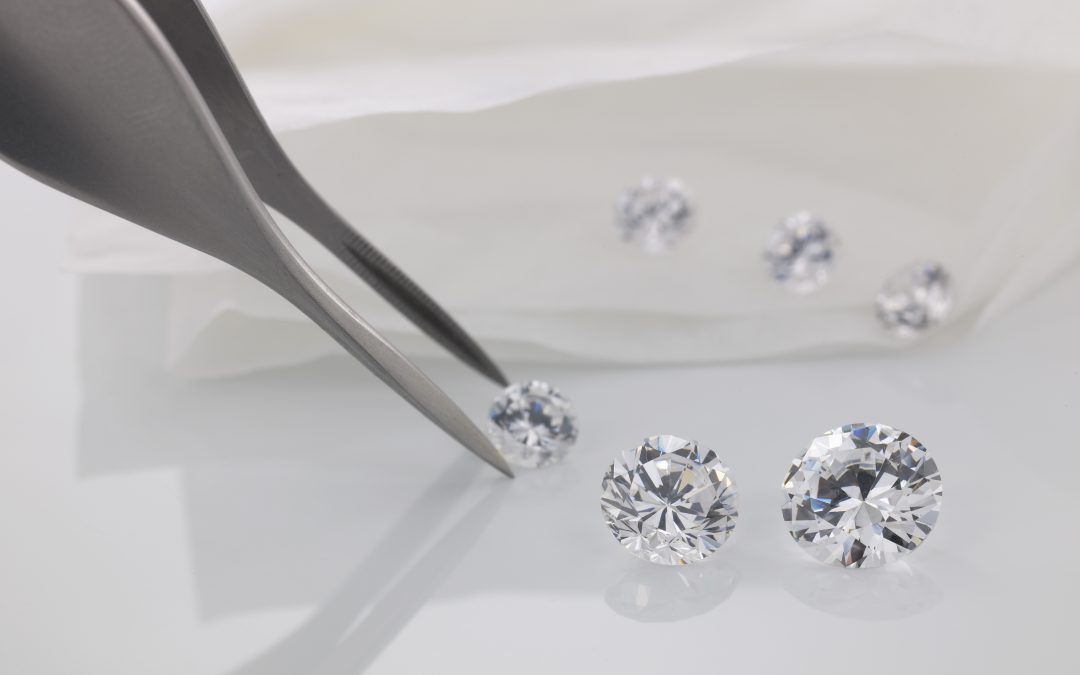
by WebHorse Main Account | Jun 28, 2022 | Jewelry 101
Lab Grown Diamond vs. Mined Diamond
Lab grown diamonds have skyrocketed in popularity in the past few decades. For the eco-conscious consumer, lab grown diamonds are a stellar option, but it can be difficult to get an unbiased opinion about them. Are these man-made diamonds worth the investment, or should you always stick with natural mined diamonds to ensure the best bang for your buck?
Here’s what you should know about lab grown diamonds versus mined diamonds.
What is a Mined Diamond?
A mined diamond, also known as a natural diamond, is formed naturally deep beneath the Earth’s crust where temperatures and pressures are very high. They’re sometimes called “natural diamonds” because they’re formed naturally and then mined when rare volcanoes erupt and bring them close to the surface.
Unfortunately, due to poor planning and weak regulation, diamond mining has prompted environmental issues such as land degradation, soil erosion, and devastation of water resources. It has even forced local communities to relocate.
For this reason, lab grown diamonds — identical in every way to earth-mined diamonds except they are grown in a lab — have become popular.

What is a Lab Grown Diamond?
Lab grown diamonds, also known as synthetic diamonds, have the same physical, chemical, and optical properties as mined diamonds. The only difference is that these stones are grown in a machine rather than in the earth. Both are made of carbon, and they will “test” as a diamond because they have identical properties.
The Advantage of Lab Grown Diamonds
Here are some of the reasons that buyers select lab grown diamonds over mined diamonds.
- Budget: If you have a small budget, you can get a bigger lab grown diamond than you would a mined diamond. They are less expensive for the same quality.
Appearance: You’ll still get the same beautiful look from a lab grown diamond that you would a mined diamond.
- Ethics: A large reason people prefer lab grown diamonds is that they have a trackable origin. Mined diamonds are at risk of being “blood” or “conflict” diamonds — traded or mined illegally in war-torn areas. Lab grown diamonds don’t carry these ethical implications.
- Sustainability: If you want an eco-friendly option, then lab-grown diamonds are the way to go. They don’t require a mining process at all. Although, they’re still not ideal for the environment because lab grown diamonds require a lot of energy to create.
The Disadvantage of Lab Grown Diamonds
Yet, lab grown diamonds aren’t perfect for every buyer. Consider these factors before purchasing.
- Resale value: Mined diamonds have a clearcut resale value because of their established history. Lab grown diamonds have seen prices fall in the past few years because of increased supply. If you want a sustained resale value, mined diamonds are a better bet.
- Perception: Lab grown diamonds can be a personal preference. They’re ideally suited for those who don’t want to impact the environment negatively or want the largest possible diamond for the budget. However, if you haven’t talked about the details of a ring or rock with your potential fiancé, it may not be the best move to surprise them with a lab grown diamond. They’re a newer option and are sometimes seen as the ”cheaper” choice.
- Custom: The gap is starting to close between lab grown and mined diamonds. However, the large majority of people still default to mined diamonds as the customary choice.

Buying a diamond — or jewelry of any kind — is a big decision. At F.A.O. Jewelers, we believe in arming our customers with the best information available, so they can make the best decision possible. If you are looking for more information on mined & lab grown diamonds or are interested in seeing them in person, give us a call at 810.229.5335, or stop by our location in Brighton, MI to see our engagement rings firsthand. For even more information, check out our Jewelry 101 blog or follow us on Facebook and Instagram.
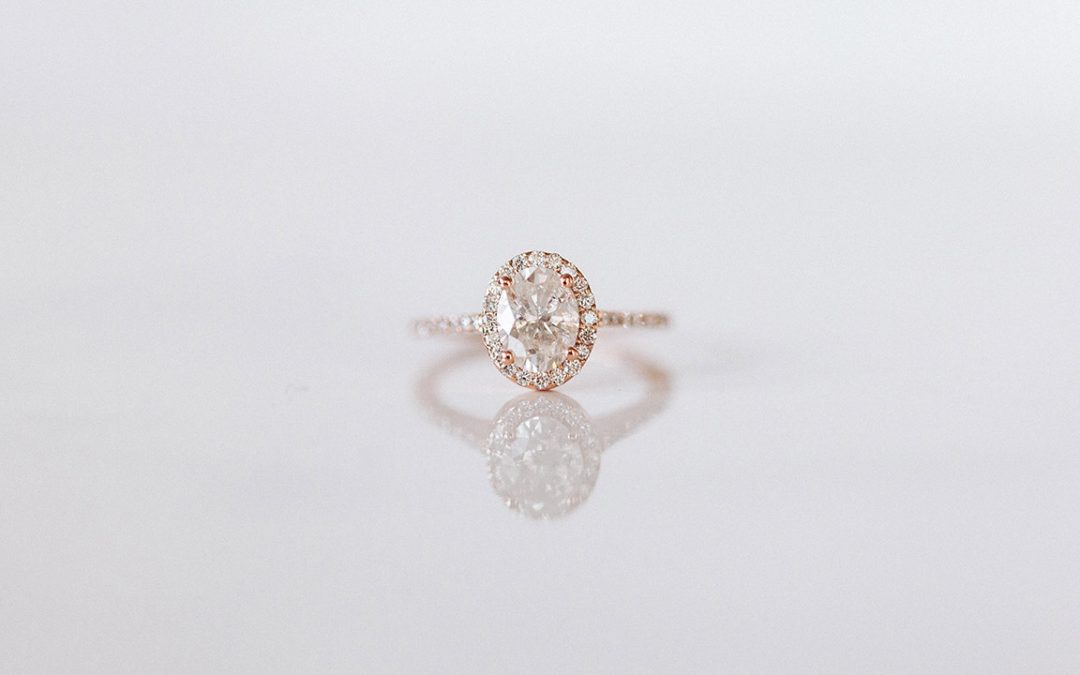
by WebHorse Main Account | Jun 23, 2022 | Jewelry 101
How Much Should You Spend On an Engagement Ring?
When it comes to engagement rings, it can be hard to know how much you should spend at the jewelry store. After all, this is a ring that will symbolize your love for one another and should last a lifetime. But still, the price is a very personal decision. With that in mind, we want to help you make the best decision when it comes to spending your money on an engagement ring diamond. We’ll go over different things you should consider when making your purchase, as well as what range of prices you can expect depending on the quality of diamond you choose. Let’s get started!
Jewelers typically suggest spending two-months’ salary on an engagement ring, but this is a guideline that doesn’t work for everyone. If you have debt or are otherwise cash-strapped, you may not be able to afford a two-month’s salary ring without going into debt. There are plenty of beautiful engagement rings out there that cost less than two months’ salary, so don’t feel like you have to spend a fortune just to pop the question!
Cut, Color, and Clarity of Diamond
When you’re looking at engagement rings, it’s important to keep in mind the “Four Cs.” The Four Cs stand for Carat, Cut, Clarity, and Color. These are the main characteristics that will affect a diamond’s quality and price.
Next, start to narrow down the type of engagement ring diamond you’re looking for. Keep in mind that carat weight, cut, clarity, and color will all affect the price of a diamond. For example, a one-carat diamond with excellent cut, clarity, and color could cost anywhere from $2000 to $5000. However, a one-carat diamond with poor cut, clarity, and color could cost as little as $200.
The sparkle factor of the ring depends directly on the cut. So, choose the ring with a brilliant cut so it will hide other things. If your budget is a bit low, you can select the ring with a bit of a yellowish color touch and less clarity, but the cut is something not to compromise on. A ring with a good cut will look fabulous in every way.
Another great way to lower the cost of a diamond is to slightly lower the carat weight. When looking at a one-carat diamond running the price of for example $2000 you can lower the weight to 0.89 carats, while keeping the same cut, clarity, and color, this could lower the price by a few hundred dollars. With the size difference not being noticeable to the naked eye.
– If your budget is low, you can compromise on color and clarity.
– Do not compromise on the cut because the cut is the ultimate source of sparkle.
– Lowering the weight of a diamond slightly under the traditional one-carat, two-carat, three-carat size, can significantly reduce the price without compromising the look of the size.
Choose the Setting According to Your Budget
Remember that your diamond ring will consist of two parts (setting and center). Once you choose the right diamond, you will then have to select the setting. The most expensive setting is the platinum setting. White gold is comparatively less expensive, so you can choose as per your partner’s choice.
– If your budget is high, you can choose the platinum setting.
– Platinum is the most expensive.
– You can also opt for white gold if your budget is a bit low.
So, how much should you spend on an engagement ring?
It’s a tough question. Just remember, you should never spend more than you are comfortable with. The most important thing is to communicate with your fiancé and set a budget that works for both of you. With a little bit of planning, you can find an engagement ring that fits your style and budget.
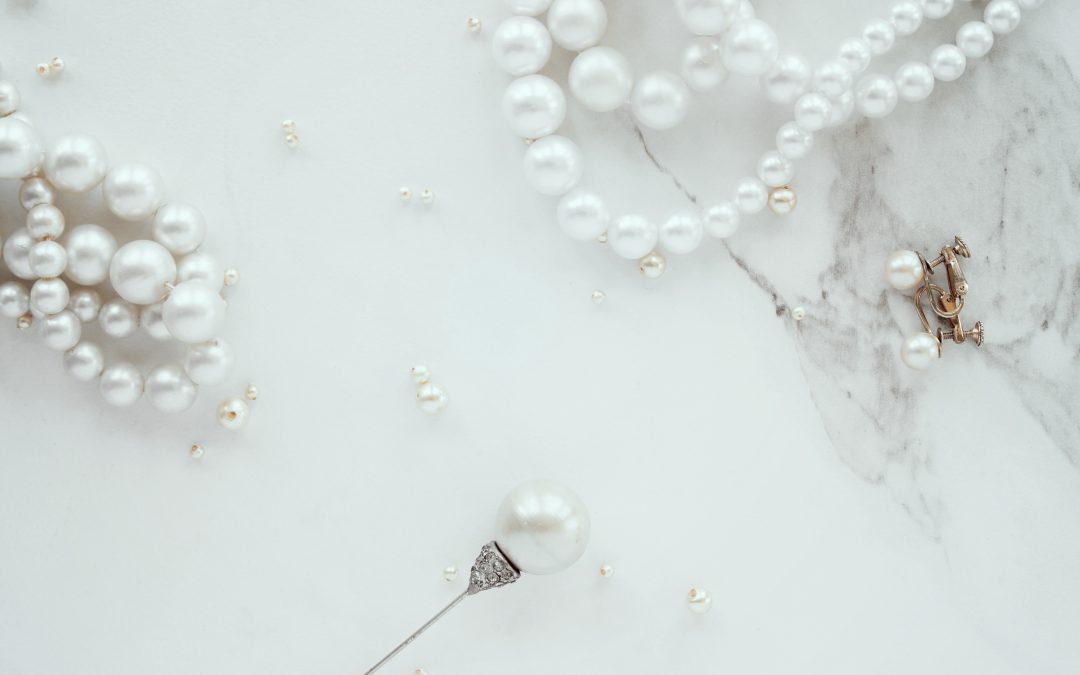
by WebHorse Main Account | Jun 9, 2022 | Jewelry 101
Birthstone of the Month: June Edition
First of all, where did the idea originate from?
Birthstones actually have a somewhat religious origin. The Exodus describes a ceremonial breastplate worn by Moses’s brother, Aaron, encrusted with 12 gems. Laden with spiritual importance, it was believed that the 12 stones were related to the twelve months of the year, as well as the zodiac signs.
Over the years, the list of stones has been modified several times, to fit the epoch, and the tastes of customers and jewelers worldwide, but the idea remains the same.
What does a birthstone do?
It’s believed that wearing the appropriate gem for your birth month brings good fortune, love and happiness. But not only that. Birthstones are thought to help clear up emotional and mental blockages, and help your spirit keep true north.
A big idea behind birthstones is that, by wearing the appropriate gem in the appropriate month, you get to channel the Universe’s healing power to your being, and that helps you navigate uncertain times in your life, and find strength.
June Birthstones
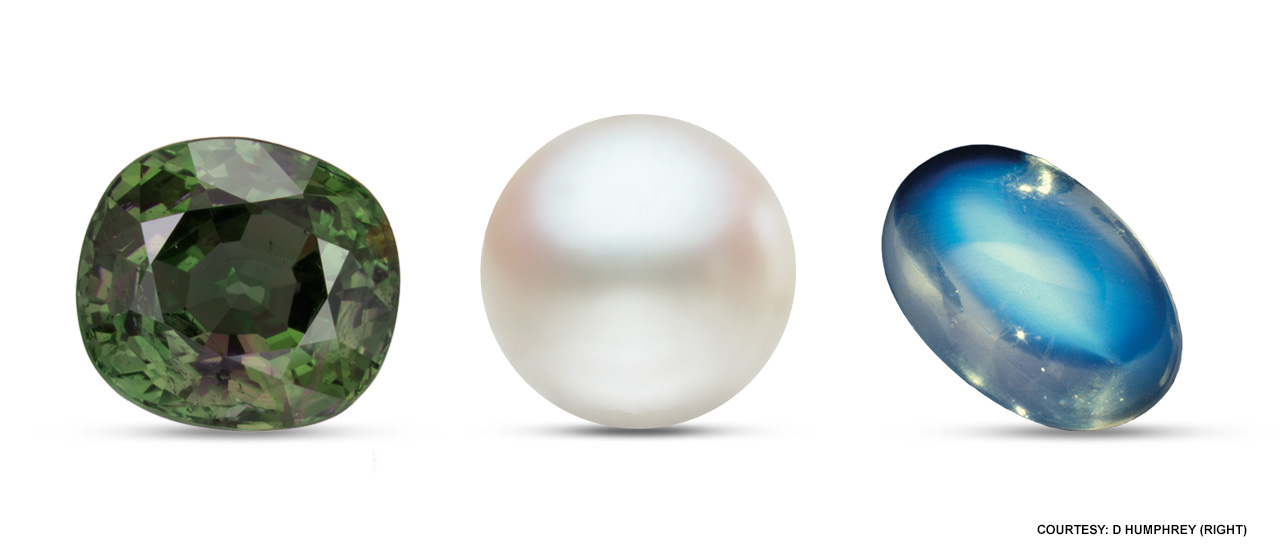 Those born in June are blessed, having not one but three gemstones to choose from: a classy pearl, a shimmering moonstone, and the wonderfully versatile alexandrite. Of course, each carries its own properties, so we urge you to choose wisely – pick the gem that best reflects your personality and your emotions. So, let’s talk a bit about them, and see which one suits you best!
Those born in June are blessed, having not one but three gemstones to choose from: a classy pearl, a shimmering moonstone, and the wonderfully versatile alexandrite. Of course, each carries its own properties, so we urge you to choose wisely – pick the gem that best reflects your personality and your emotions. So, let’s talk a bit about them, and see which one suits you best!
Pearl
Origins
Traditionally, pearls have always been considered some of the most elegant gems, as well as the most romantic ones, due to their origin. According to Greek myth, the first pearls appeared when Aphrodite, the goddess of love, emerged from the sea (famously, Aphrodite was born from the foam of the waves). The shed droplets of water that dripped off the goddess’s skin crystalized, resulting in what we today call pearls.
Through much of history, pearls were a gem destined only for the richest, most resourceful individuals, due to their incredible rarity. It was only in the 20th century, thanks to the culturing of saltwater pearls, that this astonishing gem became accessible to the general public.
Meaning
Pearls are largely thought to embody purity, modesty and general calm. As birthstones, they will keep your aim true, and are also believed to chase away anxious dispositions, and quieten worry and fear.
Pearls are romantic in a pristine, innocent way, channeling the healing power of healthy love. Speaking of which, pearls are also believed to bestow various healing properties. In Sanskrit tradition, pearls were associated with long life and prosperity, while Asian cultures link pearls to healthy digestion.
Moonstone
Origins
Named by the Roman natural historian Pliny, the moonstone is one of the most fascinating minerals on the market today. While Pliny described the changing colors of the stone, in accordance to the moon’s cycles, Hindu cultures believed this stone to be actual solidified moonbeams, thus accounting for the stone’s different shimmers of color.
It’s the thin layers of feldspar caught inside the stone that cause the light to scatter, causing adularescence. While moonstone comes in several tints (yellow, pink, orange, etc.), the classiest and finest type of moonstone is practically colorless, with a thin layer of shimmery blue.
Meaning
Because of its powerful connection with the moon and its cycles, this precious birthstone has always been associated with femininity. It’s a powerful fertility symbol, but also believed to convey other traditionally feminine qualities like softness and intuition. By sporting moonstone, you’re channeling divine feminine energy, and celebrating the goddess in yourself.
Moonstone is also a gem that represents change (much like the cyclical lunar transitions) and inner clarity. People wearing moonstone might be going through a time of transition, and struggling to find their way. This potent birthstone is thought to help them see the way, and find stability in a new phase of their life.
Alexandrite
Origins
First discovered in the Ural Mountains, in Russia, this relatively modern gemstone is named for the then-heir apparent, the future Czar Alexander II. At its core, alexandrite is a very rare type of chrysoberyl, a popular mineral. The reason why alexandrite has, since its discovery, become so popular, is its unusual chemical composition, which allows it to change its colors. This allows alexandrite to shift from pale, emerald-like red (due to its chromium content) to deep ruby red.
To date, one of the rarest gemstones is thought to be cat’s eye alexandrite, which is an effect obtained through thin, appropriately-oriented inclusions into the stone, which create a cat’s eye effect.
Meaning
Because of its Imperial origins, alexandrite is thought to be a very regal, very noble birthstone. Alexandrite is associated with an increase in self-esteem, and a shift in attitude. It encourages the wearer to find joy in every situation and to nurture self-respect and inner light. In time, this allows one to navigate difficult situations, and not lose heart.
Alexandrite is also a stone of physical wellbeing. It’s associated with healthy circulation, and thought to restore balance inside the wearer’s body. To put it simply, alexandrite steers you away from negative energies (physical, mental or emotional) and orients your soul towards light and freedom.
How to wear your June birthstone
June babies are lucky, since the month’s three birthstones offer a lot of versatility. Each of the three stones can be worn independently, or you can use other gems to compliment them. Alexandrite, thanks to its green sheen, pairs remarkably with emerald, while the deep blue hues of moonstone contrast well against diamonds.
Pearls, because of their impressive range, can be accessorized with several gems, including moonstone and alexandrite, if you’re looking to channel all three of June’s birthstones.
Looking For More Information?
If you are looking for more information on birthstones or are interested in seeing them in person, give us a call at 810.229.5335, or stop by our location in Brighton, MI to see our engagement rings firsthand. For even more information, check out our Jewelry 101 blog or follow us on Facebook and Instagram.
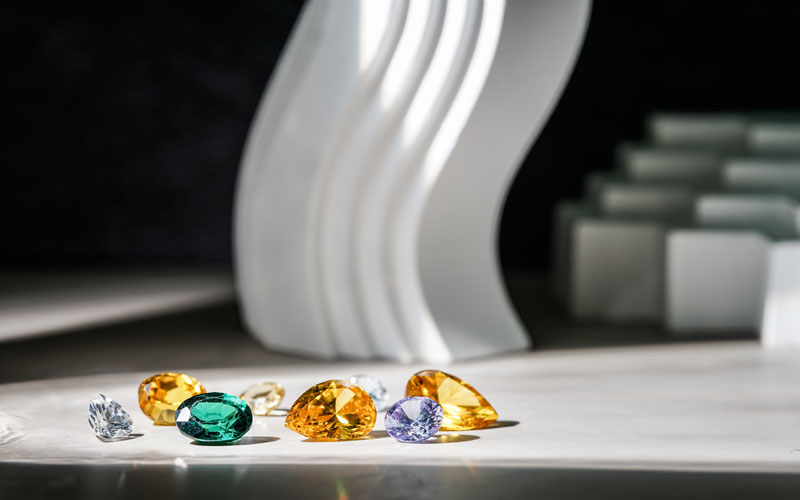
by WebHorse Main Account | Apr 21, 2022 | Jewelry 101
When it comes to gemstones for engagement rings, diamonds are by far the most popular. There are tons of practical reasons most people choose diamonds for their engagement ring – they’re incredibly strong and stunningly beautiful – but these lovely gemstones definitely aren’t your only choice. If you’re looking for something more unique, these are the 6 best gemstones for engagement rings – that aren’t diamonds.
Ruby

Rubies are among the hardest known minerals, making them the perfect choice for something that will be worn every day – like an engagement ring. Besides their incredible strength, rubies are breathtakingly beautiful. The rich red hues of these stunning gemstones make them the perfect representation for love, romance, and passion.
Mohs Hardness Rating: 9
Sapphire
Another super-tough gemstone that’s perfect for an engagement ring is a sapphire. Best known for their deep, royal blue color, sapphires actually come in just about every color except red. Some sapphires even have a special property called pleochroism, where the gem changes colors based on how you look at it.
If you’re looking for something really special, check out star sapphire rings. These unique stones sport a scintillating star pattern in the center of the sapphire. The result is a truly unique and utterly beautiful piece of jewelry.
Mohs Hardness Rating: 9
Topaz
If you’re looking for a versatile gemstone with tons of beautiful colors and cuts to choose from, then let’s introduce you to Topaz. Topaz is one of the best gemstones for engagement rings because there are options and variations that suit just about everybody’s taste.
Not only does topaz come in a wide variety of colors, from blue and purple to red and orange, but they’re tough as well. Coming in at an 8 on the Mohs Hardness Scale, topaz is durable enough to wear everyday and beautiful enough to show off to everyone you know.
Mohs Hardness Rating: 8
Spinel
Spinel is one of the most beautiful gemstones on earth. So beautiful, in fact, they are often mistaken for rubies. The Black Prince’s Ruby, a world-famous gemstone and one of the Crown Jewels of the UK, is actually a world class spinel that was mistaken for a ruby for over 1,000 years.
With a hardness rating of 8 and the type of beauty that can fool royalty for over a millennia, Spinel is one of the best gemstones for engagement rings.
Mohs Hardness Rating: 8
Emerald

If you’re looking for a gemstone that’s instantly recognizable and perpetually beautiful, an emerald may be the perfect choice for your engagement stone. This verdant gem rates between 7.5 – 8 on the Mohs hardness scale, meaning emeralds are strong enough to handle the everyday wear of an engagement ring.
If you have a partner who has a thing for green, then choosing an emerald for your engagement ring should be a no-brainer.
Mohs Hardness Rating: 7.5 – 8
Aquamarine
Another excellent option when it comes to alternate gemstones for engagement rings is aquamarine. This lovely stone comes in colors reminiscent of the watery world for which they’re named. This sea-colored gem is the perfect choice for someone who has an affinity for the ocean and is more than capable of holding its own in comparison to over gems.
Not only are aquamarine engagement rings beautiful and romantic, but they’re extremely tough as well. Coming in at a hardness rating of 7.5 – 8, there are only a few gems harder than aquamarine.
Mohs Hardness Rating: 7.5 – 8
Honorable Mentions – Moissanite
I think that no list of alternate gemstones for engagement rings is complete without mentioning Moissanite. With a hardness rating of 9.5, only diamonds are tougher than Moissanite, but nothing compares to the sheer brilliance of this otherworldly stone.
Moissanite might just be the rarest gem on earth, mostly because it’s actually extraterrestrial. First discovered in a meteorite in the late 1800s, Moissanite is so difficult to find in nature that it’s now exclusively made in the lab. These lab-made gems have the exact same composition, beauty, and toughness of their spacefaring siblings, but at a much more reasonable price.
Mohs Hardness Rating: 9.5
Design the Perfect Engagement Ring at F.A.O. Jewelers in Brighton, MI
When deciding on the best gemstones for your engagement ring, you don’t have to do it alone. The jewelry design experts here at F.A.O. Jewelers are here to help. With a huge supply of different high-quality gemstones, we can help you make the engagement ring of your dreams.
Give us a call at 810.229.5335, or stop by our location in Brighton, MI to see our engagement rings firsthand. For even more information, check out our Jewelry 101 blog or follow us on Facebook and Instagram.

by WebHorse Main Account | Feb 9, 2022 | Jewelry 101
As far as gifts go, you can’t beat a beautiful piece of jewelry. No matter what the occasion; it could be Christmas, Mother’s Day, birthdays, anniversaries, or just-because, gifting someone you love with a beautiful piece of fine jewelry is an excellent (and popular) way to show them how much you care. The question now becomes: how to find the right jeweler? Lucky for you, we’ve put some serious thought into this and came up with the definitive list of 6 things to look for when choosing a jeweler.
5 Tips to Help You Find the Right Jeweler
Only Buy From Professionals
The first and most obvious thing to look for when choosing a jeweler is… are they even a jeweler? Don’t get me wrong, I’m sure there are plenty of great people offering to sell you an engagement ring out of the trunk of their car or a fancy “new” watch out of the hidden pocket in their trench coat, but those great people probably aren’t professional jewelers. Buying jewelry from a professional jeweler comes with a few undeniable perks. Most notably, a professional jeweler knows what they’re talking about, and I don’t mean memorizing a sales pitch. Professional jewelers can offer you the best information, guidance, and advice on all of their pieces. They should know everything about the piece of jewelry, from how it was made to where the gemstones and materials originated from.
High-Quality Diamonds, Gems, and Metals
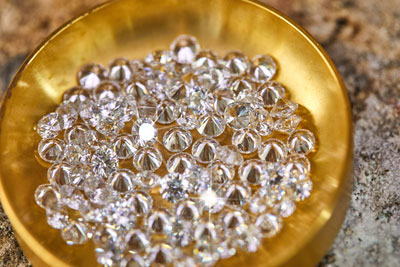 Going along with our theme of education, another thing to look for when choosing a jeweler is how well they know their products, materials, and their craft in general. They should be able to answer your questions about gemstones, diamonds, metal quality, and anything else related to your piece of jewelry. We put together a short list of strategic questions to ask to help you find the right jeweler.
Going along with our theme of education, another thing to look for when choosing a jeweler is how well they know their products, materials, and their craft in general. They should be able to answer your questions about gemstones, diamonds, metal quality, and anything else related to your piece of jewelry. We put together a short list of strategic questions to ask to help you find the right jeweler.
Questions Every Jeweler Should be Able to Answer:
- Are your diamonds conflict-free?
- What are the strengths, weaknesses, and general characteristics of different gemstones?
- What’s the difference between the “Cut” and the “Shape” of a gemstone?
- Do you know the difference between a Karat, a Carat, and a Carrot?
- Can you explain the 4 C’s of diamonds?
- Are your diamonds and gemstones verified and certified through a respected, third-party organization, like the Gemological Institute of America (GIA)?
Reputation Matters
When it comes to finding the right jeweler, reputation definitely matters. Checking their reviews and social media accounts is an important part of the finding-a-jeweler process. Pay attention to the good reviews, the bad reviews, AND their responses to the bad reviews. You can tell a lot about a company by looking at their responses to bad reviews. Are they helpful? Dismissive? Do they own their mistakes and offer up solutions or do they come up with catty excuses? The answers to these questions should give you some insight into how you’ll be treated at this jewelry store.
Best Ways to Check the Reputation of a Jewelry Store:
- Ask around for recommendations.
- Check them out on social media.
- Check their online reviews.
- How long have they been around?
- Are they locally-owned?
Do They Care?
Ok, this may seem like a pretty low bar, but you’d be surprised at how important this question is. Unfortunately, it’s too easy to walk into a big-name jewelry store, like Tiffany & Co., Jared, or Kay Jewelers, and just become another number on a spreadsheet. Going to a Jewelry shop where the jewelers genuinely care about their customers is the best way to ensure you’re getting the best treatment possible. A jeweler who cares is much more likely to go above and beyond, making sure you feel heard and appreciated.
Post-Purchase Perks
Finally, a good thing to keep in mind when choosing a jeweler is what happens after the purchase. Ask whether or not they offer things like a life-time warranty, free repairs, free cleaning and polishing, updated appraisals, and financing options. The answers to these important questions will help you find your forever jewelry store.
Look No Further: F.A.O. Jewelers is Here for You
If you’re looking for the right jeweler, then you’ve come to the right place. Here at F.A.O. Jeweler, we combine the care and personalized attention of a locally-owned jewelry shop with the high-quality professionalism and incredible jewelry selection of a big brand. In the end, we know that it’s all about you and your experience with us. That’s why we’re dedicated to providing the absolute best customer experience imaginable. Stop in to have a conversation with one of our professional gemologists or design specialists. We’d love to be your forever jewelry store. For more information, give us a call at (810) 229-5335 in Brighton or (810) 632-0202 in Hartland. You can also check us out on Facebook and Instagram for more pictures, reviews, and information about us. Check out our Jewelry 101 Blog for more helpful information on our jewelry, gemstones, diamonds and more.








 Those born in June are blessed, having not one but three gemstones to choose from: a classy pearl, a shimmering moonstone, and the wonderfully versatile alexandrite. Of course, each carries its own properties, so we urge you to choose wisely – pick the gem that best reflects your personality and your emotions. So, let’s talk a bit about them, and see which one suits you best!
Those born in June are blessed, having not one but three gemstones to choose from: a classy pearl, a shimmering moonstone, and the wonderfully versatile alexandrite. Of course, each carries its own properties, so we urge you to choose wisely – pick the gem that best reflects your personality and your emotions. So, let’s talk a bit about them, and see which one suits you best!



 Going along with our theme of education, another thing to look for when choosing a jeweler is how well they know their products, materials, and their craft in general. They should be able to answer your questions about gemstones, diamonds, metal quality, and anything else related to your piece of jewelry. We put together a short list of strategic questions to ask to help you find the right jeweler.
Going along with our theme of education, another thing to look for when choosing a jeweler is how well they know their products, materials, and their craft in general. They should be able to answer your questions about gemstones, diamonds, metal quality, and anything else related to your piece of jewelry. We put together a short list of strategic questions to ask to help you find the right jeweler.